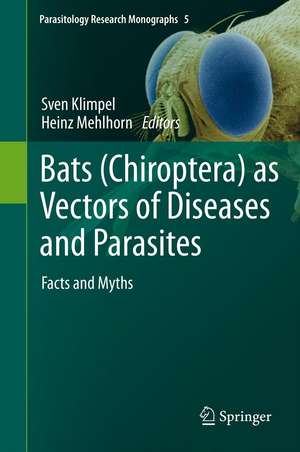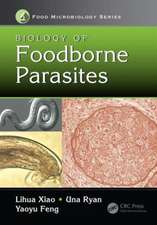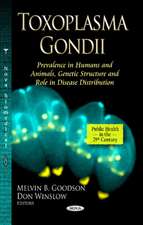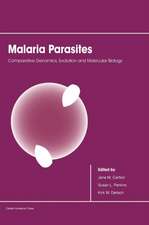Bats (Chiroptera) as Vectors of Diseases and Parasites: Facts and Myths: Parasitology Research Monographs, cartea 5
Editat de Sven Klimpel, Heinz Mehlhornen Limba Engleză Hardback – 23 oct 2013
Bats have been known in different cultures for several thousand centuries, however their nocturnal activities have made them mysterious and led to many legends and myths, while proven facts remained scarce. Even today, our knowledge of bats remains limited compared to other groups in the animal kingdom. Also, their famous ability to avoid collisions with obstacles during their nightly flights with the help of a sophisticated and unique system using ultrasound waves (which are transmitted and received) is as poorly studied as birds finding their way from continent to continent. In recent times, where globalization transports millions of people and goods from one end of the earth to the other, there are increased risks posed by agents of diseases, as a result of which bats have received increasing attention as potential vectors. These suppositions are based on their proven transmission of viruses such as rabies.
In dedicated chapters, the book addresses the following topics:
• The world of bats
• The astonishing morphology of bats
• Bats as potential reservoir hosts for vector-borne diseases
• Bat endoparasites
• Macroparasites – ectoparasites
• Glimpses into how bats fly
• Blood-licking bats
• Vampirism in medicine and culture
• Chupacabras and “goat milkers”
• Myths on candiru
As such, this book provides a broad range of information for all non-experts interested in biological topics, but also for people working in this field, as well as physicians and veterinarians who are confronted with clinical cases, and for teachers and students interested in expanding their knowledge of biology and of past and present cultures.
| Toate formatele și edițiile | Preț | Express |
|---|---|---|
| Paperback (1) | 939.94 lei 6-8 săpt. | |
| Springer Berlin, Heidelberg – 23 aug 2016 | 939.94 lei 6-8 săpt. | |
| Hardback (1) | 945.92 lei 6-8 săpt. | |
| Springer Berlin, Heidelberg – 23 oct 2013 | 945.92 lei 6-8 săpt. |
Din seria Parasitology Research Monographs
- 15%
 Preț: 644.95 lei
Preț: 644.95 lei - 18%
 Preț: 1113.39 lei
Preț: 1113.39 lei - 18%
 Preț: 1221.38 lei
Preț: 1221.38 lei - 24%
 Preț: 904.14 lei
Preț: 904.14 lei - 18%
 Preț: 940.87 lei
Preț: 940.87 lei - 18%
 Preț: 952.57 lei
Preț: 952.57 lei - 18%
 Preț: 727.00 lei
Preț: 727.00 lei - 18%
 Preț: 1104.43 lei
Preț: 1104.43 lei - 18%
 Preț: 781.45 lei
Preț: 781.45 lei - 18%
 Preț: 1105.68 lei
Preț: 1105.68 lei - 18%
 Preț: 944.99 lei
Preț: 944.99 lei - 18%
 Preț: 1114.02 lei
Preț: 1114.02 lei - 18%
 Preț: 1112.60 lei
Preț: 1112.60 lei - 18%
 Preț: 1219.46 lei
Preț: 1219.46 lei - 18%
 Preț: 1226.73 lei
Preț: 1226.73 lei - 18%
 Preț: 946.55 lei
Preț: 946.55 lei - 18%
 Preț: 950.21 lei
Preț: 950.21 lei - 20%
 Preț: 563.85 lei
Preț: 563.85 lei
Preț: 945.92 lei
Preț vechi: 1153.57 lei
-18% Nou
Puncte Express: 1419
Preț estimativ în valută:
181.02€ • 196.56$ • 152.06£
181.02€ • 196.56$ • 152.06£
Carte tipărită la comandă
Livrare economică 22 aprilie-06 mai
Preluare comenzi: 021 569.72.76
Specificații
ISBN-13: 9783642393327
ISBN-10: 3642393322
Pagini: 165
Ilustrații: XII, 187 p. 35 illus., 33 illus. in color.
Dimensiuni: 155 x 235 x 20 mm
Greutate: 0.46 kg
Ediția:2014
Editura: Springer Berlin, Heidelberg
Colecția Springer
Seria Parasitology Research Monographs
Locul publicării:Berlin, Heidelberg, Germany
ISBN-10: 3642393322
Pagini: 165
Ilustrații: XII, 187 p. 35 illus., 33 illus. in color.
Dimensiuni: 155 x 235 x 20 mm
Greutate: 0.46 kg
Ediția:2014
Editura: Springer Berlin, Heidelberg
Colecția Springer
Seria Parasitology Research Monographs
Locul publicării:Berlin, Heidelberg, Germany
Public țintă
ResearchCuprins
The World of Bats.- The Astonishing Morphology of Bats.- Bats as Potential Reservoir Hosts for Vector-Borne Diseases.- Bat Endoparasites.- Macroparasites – Ectoparasites.- Glimpses into how Bats Fly.- Blood-Licking Bats.- Vampirism in Medicine and Culture.- Chupacabras and “Goat Milkers”.- Myths on Candiru.
Recenzii
From the reviews:
“From bat biology to parasites of bats to vampirism, this book covers a wide range of topics. The purpose is to share knowledge about different features of bats, including morphology, potential vectorship of infectious diseases, and parasites of bats. The intended audience includes those involved in bat research and public health.” (Adam W. Stern, Doody’s Book Reviews, February, 2014)
“From bat biology to parasites of bats to vampirism, this book covers a wide range of topics. The purpose is to share knowledge about different features of bats, including morphology, potential vectorship of infectious diseases, and parasites of bats. The intended audience includes those involved in bat research and public health.” (Adam W. Stern, Doody’s Book Reviews, February, 2014)
Textul de pe ultima copertă
This book gathers contributions by 16 international authors on the phenomenon “bats,” shedding some light on their morphology, the feeding behaviors (insects, fruits, blood) of different groups, their potential and confirmed transmissions of agents of diseases, their endo- and ectoparasites, as well as countless myths surrounding their lifestyle (e.g. vampirism, chupacabras, batman etc.).
Bats have been known in different cultures for several thousand centuries, however their nocturnal activities have made them mysterious and led to many legends and myths, while proven facts remained scarce. Even today, our knowledge of bats remains limited compared to other groups in the animal kingdom. Also, their famous ability to avoid collisions with obstacles during their nightly flights with the help of a sophisticated and unique system using ultrasound waves (which are transmitted and received) is as poorly studied as birds finding their way from continent to continent. In recent times, where globalization transports millions of people and goods from one end of the earth to the other, there are increased risks posed by agents of diseases, as a result of which bats have received increasing attention as potential vectors. These suppositions are based on their proven transmission of viruses such as rabies.
In dedicated chapters, the book addresses the following topics:
• The world of bats
• The astonishing morphology of bats
• Bats as potential reservoir hosts for vector-borne diseases
• Bat endoparasites
• Macroparasites – ectoparasites
• Glimpses into how bats fly
• Blood-licking bats
• Vampirism in medicine and culture
• Chupacabras and “goat milkers”
• Myths on candiru
As such, this book provides a broad range of information for all non-experts interested in biological topics, but also for people working in this field, as well as physicians and veterinarians who are confronted with clinical cases, and for teachers and students interested in expanding their knowledge of biology and of past and present cultures.
Bats have been known in different cultures for several thousand centuries, however their nocturnal activities have made them mysterious and led to many legends and myths, while proven facts remained scarce. Even today, our knowledge of bats remains limited compared to other groups in the animal kingdom. Also, their famous ability to avoid collisions with obstacles during their nightly flights with the help of a sophisticated and unique system using ultrasound waves (which are transmitted and received) is as poorly studied as birds finding their way from continent to continent. In recent times, where globalization transports millions of people and goods from one end of the earth to the other, there are increased risks posed by agents of diseases, as a result of which bats have received increasing attention as potential vectors. These suppositions are based on their proven transmission of viruses such as rabies.
In dedicated chapters, the book addresses the following topics:
• The world of bats
• The astonishing morphology of bats
• Bats as potential reservoir hosts for vector-borne diseases
• Bat endoparasites
• Macroparasites – ectoparasites
• Glimpses into how bats fly
• Blood-licking bats
• Vampirism in medicine and culture
• Chupacabras and “goat milkers”
• Myths on candiru
As such, this book provides a broad range of information for all non-experts interested in biological topics, but also for people working in this field, as well as physicians and veterinarians who are confronted with clinical cases, and for teachers and students interested in expanding their knowledge of biology and of past and present cultures.
Caracteristici
Covers the morphology and biology of bats and the potential vectorship of agents of diseases and parasites Special attention is given at the numerous myths that had been told or are still told on these unique organisms Presents some of the most interesting and most important findings in bat research Includes supplementary material: sn.pub/extras






